 In recent years, the court has made it very difficult, and often impossible, to hold police officers and the governments that employ them accountable for civil rights violations. This undermines the ability to deter illegal police behavior and leaves victims without compensation. When the police kill or injure innocent people, the victims rarely have recourse.
In recent years, the court has made it very difficult, and often impossible, to hold police officers and the governments that employ them accountable for civil rights violations. This undermines the ability to deter illegal police behavior and leaves victims without compensation. When the police kill or injure innocent people, the victims rarely have recourse.
A recent court ruling (May, 2014) that favored the police was Plumhoff v. Rickard which found that even egregious police conduct is not “excessive force” in violation of the Constitution.
Police officers in West Memphis, Ark., pulled over a white Honda Accord because the car had only one operating headlight. Rather than comply with an officer’s request to get out of the car, the driver made the unfortunate decision to speed away. The police chased the car for more than five minutes, reaching speeds of over 100 miles per hour. Eventually, officers fired 15 shots into the car, killing both the driver and a passenger.
The Supreme Court reversed the decision of the Court of Appeals for the Sixth Circuit and ruled unanimously in favor of the police. Justice Samuel A. Alito Jr. said that the driver’s conduct posed a “grave public safety risk” and that the police were justified in shooting at the car to stop it. The court said it “stands to reason that, if police officers are justified in firing at a suspect in order to end a severe threat to public safety, the officers need not stop shooting until the threat has ended.”
This is deeply disturbing.
The Supreme Court now has said that whenever there is a high-speed chase that could injure others — and that would seem to be true of virtually all high-speed chases — the police can shoot at the vehicle and keep shooting until the chase ends. Obvious alternatives could include shooting out the car’s tires, or even taking the license plate number and tracking the driver down later. After all, we are talking about a minor violation that most likely did not warrant a high speed pursuit to apprehend the driver (and who else occupied the car?),


With the Supreme Court looking like it will be conservative again, the people are going to get screw by the 5 to 4 decision on anything involving the police misconduct, corruption and/or brutality.
LikeLike
Certainly, Chemerinsky has forgotten more law than I’ll ever know, and the wisdom of a high-speed pursuit over a minor equipment violation can be debated, but this essay brings several thoughts to mind.
First, Plumhoff v. Rickard was a 9-0 decision. Given the Court’s ideological diversity, that speaks volumes.
Also, the officers “did not fire more shots than necessary to end the public safety risk.” “It’s not as if the officers “initiated a second round of shots after an initial round had clearly incapacitated [Rickard] and ended any threat of continued flight, or if [he] had clearly given himself up. But that is not what happened.”
Further, the Plumhoff holding was arguably foreseeable to those who read Scott v. Harris broadly, as a use of force decision, rather than narrowly as a pursuit case. In fact, shortly after Scott was decided, a well-known police attorney asked whether Scott would allow police to end a pursuit by deploying a sniper on an overpass…
LikeLike